ACWS Skippers First Impressions on
Racing in San Francisco
Winds, Tides, Currents, and Tactics
August 21, 2012
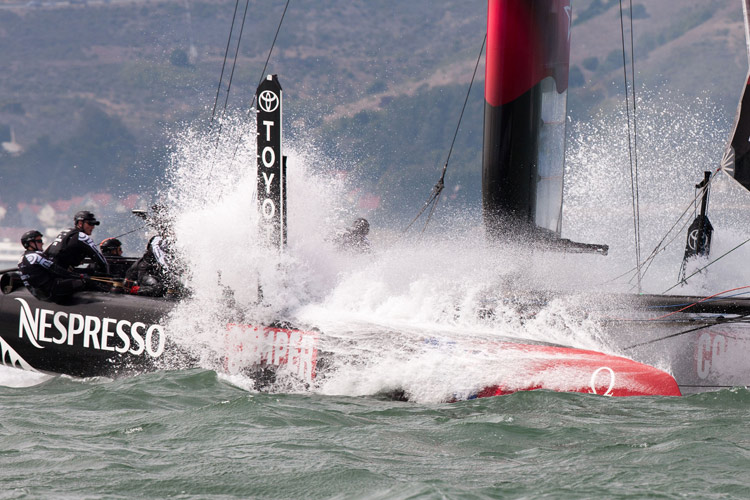
Photo:©2012 ACEA/Gilles
Martin-Raget
 Dean Barker, Emirates Team New Zealand:
Dean Barker, Emirates Team New Zealand:
"Itís been quite interesting. A lot of us have sailed here in the
past in different boats but never in catamarans. Your recollection of
what the bay has to offer can be a little different. Itís been real
eye opener in the past few days Ė weíve had three days of practice so
far in relatively strong winds at the end of each day, which keeps you
on your toes. You understand the game pretty quickly Ė knowledge of
the currents and understanding the geographical influences of the bay
is key. We all have our work cut out for us."
"But the current is no stranger for us, we deal with it at home a lot. In a lot of ways, Auckland harbor is similar to here. So I think weíll be fortunate in a way; that weíll be able to do a lot of our practicing in an environment thatís similar, though itís never completely the same. I think everyoneís enjoyed the sailing weíve done here so far, though 11 boats charging into the first gate is going to be quite a challenge."

Photo:©2012 ACEA/Gilles
Martin-Raget
![]() Phil Robertson, China Team:
Phil Robertson, China Team:
"The waves are probably the hardest part to deal with. I think this
week during the racing might be a little better, since weíve got a
flood tide. The current will be coming in all day with the wind, so
it should be a lot flatter and easier to sail the boats - which is
good, because it means we can push it a little harder. Itís going to
be exciting. Weíve had a blast out there, itís been windy every day
and we havenít capsized yet!"
"But I imagine the racing is going to be like something weíve never seen before. Youíve got to be a little careful, I think, a little bit wary and keep your eyes open. Iíve been around a mark in 20 knots sailing these boats once with three boats wide, but now with 11 boats wide itís going to be a different story. Itís going to be very exciting; I wonít be surprised if we have a few crashes there. Itís a really challenging boat to sail, but if you put one foot wrong, it can go really bad. Weíve experienced that a little bit in the past and we know that youíve got to nail everything. Itís got to be really fluid and really smooth, so itís definitely a challenge. As the day goes on, the crew gets more tired, and thatís when mistakes start to happen a little bit more, so thatís probably the challenge, to be fit enough and strong enough to sail them."
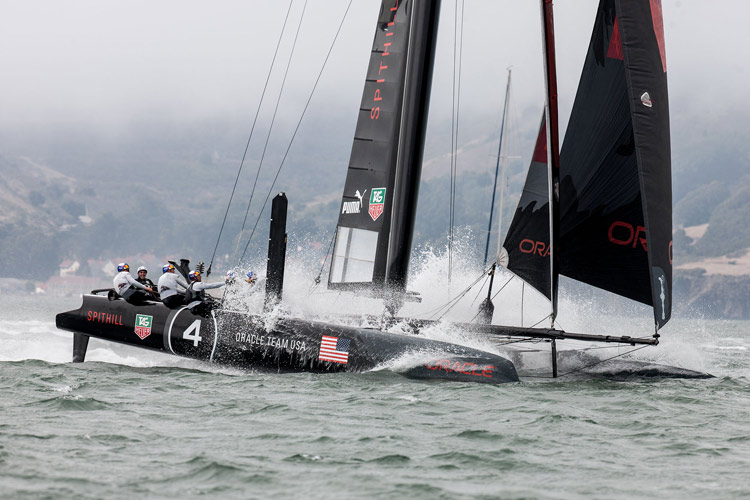
Photo:©2012 ACEA/Gilles
Martin-Raget
 James Spithill, Oracle Team USA:
James Spithill, Oracle Team USA:
"I think it will look awesome with all 11 boats out there Ė I canít
wait. I think a lot of teams have put in some big hours training
and have come to grips with the conditions. There have been a
lot of capsizes already and a lot of damage out there, but I think it
will be an incredible racetrack."
"But the cool thing about San Francisco Bay is I donít think you ever fully come to grips with it Ė and thatís why itís exciting as athletes to sail here, because itís challenging. Youíre pushed here every single day; the currents are always a little bit different, wind speed, fog, wind direction changes. And the boats are just so physical in these sorts of conditions. I really do think that this bay is one of the best places to race in the world and I think the people of San Francisco will really enjoy this racing."
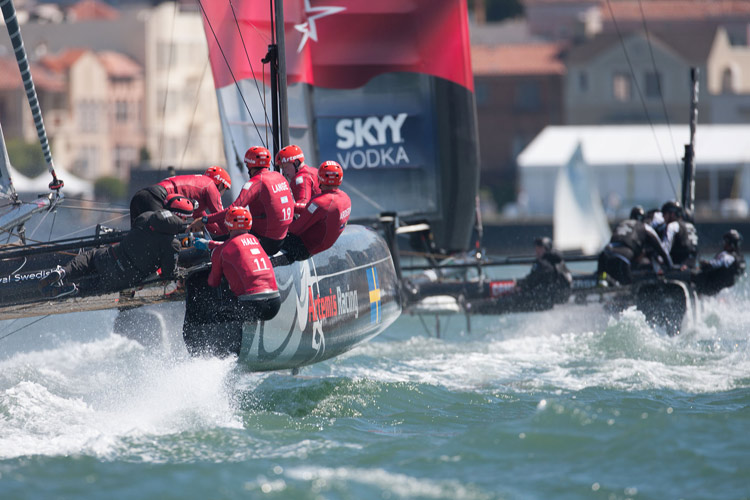
Photo:©2012 ACEA/Gilles
Martin-Raget
 Terry Hutchinson, Artemis Racing:
Terry Hutchinson, Artemis Racing:
"Eleven boats racing on this racetrack is going to be crazy. Our goal
is to get through the early parts of the regatta so we have an
opportunity Sunday to put forward a good race, since the points are
skewed toward that last race. So that means avoiding the big mistakes
and avoiding the capsizes. Weíve done those in the past Ė in two of
the six events last year, we flipped over during the early parts of
the regatta, and that has a pretty big impact on the overall result."
"Iíve done a lot of Big Boat Series and other racing here and all the same theories apply Ė when youíre in the flood ,you want to get along the shore and if youíre in an ebb, you want to be as far out as you can. Weíve worked hard to develop current playbooks and to understand that element of it, but this is a tricky little spot, along the wall here. Along the St. Francis Yacht Club, you can get the occasional lefty, so if youíre in a worse tide but you have a good angle, itís not that bad. But being heads up Ė and we all have our own on the boat Ė thatís where we really have to do a good job."
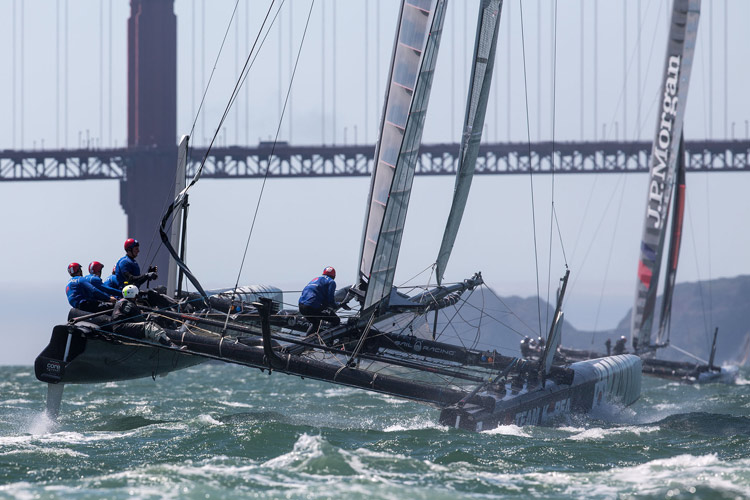
Photo:©2012 ACEA/Gilles
Martin-Raget
![]() Nathan Outteridge, Team Korea:
Nathan Outteridge, Team Korea:
"Itís a very difficult venue but I think itís a great place to sail.
Iíve sailed here a couple of time here before and I know that off the
city front here, thereís quite a bit of current and you need to
know what direction itís going, how fast and where it spins around.
Iím slowly getting an idea of that, but obviously the Oracle boys have
a huge advantage on the whole fleet, theyíve been doing it for a long
time. But itís not just the current, itís the wind strength, the
chop and the shifts and itís going to be difficult for everyone."
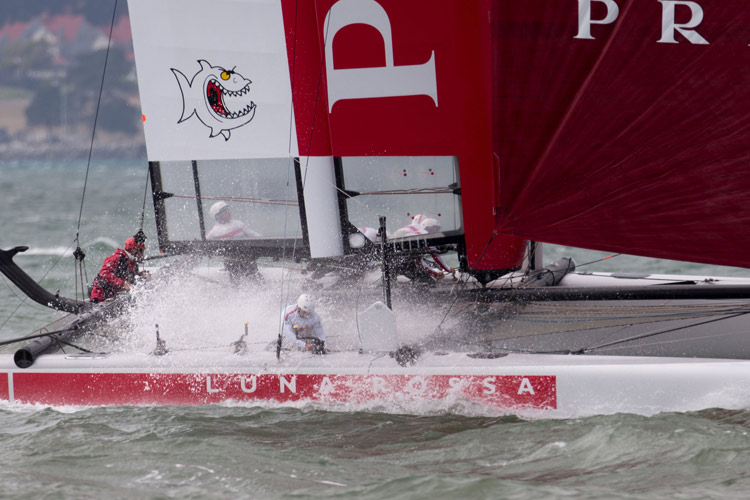
Photo:©2012 ACEA/Gilles
Martin-Raget
 Max Sirena, Luna Rossa Challenge 2013:
Max Sirena, Luna Rossa Challenge 2013:
"The main problem here is actually the chop more than the breeze,
because when the tide is against the wind, we have a pretty short,
high chop. So itís a little hard, especially when you are around the
reaching marks. But we need to get used to this condition because
this is what weíll race the Americaís Cup in."
"We came here a couple of days early to get a little bit of confidence with the race course, but we had a capsize with the boat. I think itís going to happen again, either to us or to another team, because the conditions are pretty tough - especially when youíre practice racing, because youíre pushing sometimes even harder than when youíre racing. You want to know what the limit is, so we need to use the time here as much as possible to get used to the race course."

Photo:©2012 ACEA/Gilles
Martin-Raget
 Ben Ainslie, J.P. Morgan/Ben Ainslie Racing:
Ben Ainslie, J.P. Morgan/Ben Ainslie Racing:
"Thereís a good breeze here, so itís great for these types of boats.
Weíre going to see some fantastic racing. With everyone out there,
itís going to be full on Ė itís going to be some good action.
And I have to say, after only two days of sailing the boats, that
theyíre fantastic. Theyíre really amazing. Itís really enjoyable being
out there and I think weíre going to see some great racing."
--Diane Swintal for CupInfo/©2012
CupInfo.com